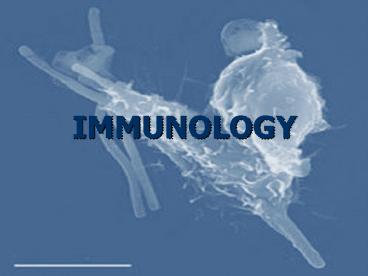IMMUNOLOGY - PowerPoint PPT Presentation
1 / 28
Title:
IMMUNOLOGY
Description:
Proteins of the complement system. Membrane receptors. Receptors for mannose residues ... Located under epithelia to easily capture the entering microbes ... – PowerPoint PPT presentation
Number of Views:286
Avg rating:3.0/5.0
Title: IMMUNOLOGY
1
IMMUNOLOGY
2
- An immune system is a collection of mechanisms
within an organism that protects against disease
by identifying and killing pathogens and tumor
cells.
3
INTRODUCTION
- INNATE IMMUNITY
- ADAPTIVE IMMUNITY
4
Components of Innate Immunity
- Epithelial barriers
- Phagocytic cells
- Natural killer cells
- Plasma proteins
- Proteins of the complement system
5
Membrane receptors
- Receptors for mannose residues
- N-formyl methionine containing peptides
- Toll like receptors
6
- recognition of microbial structure
- TLRs activate transcription factors(NF-kB)
- NF-kB cytokines
- Reactive oxygen species
- Destruction of microbes
7
Components of Adaptive Immunity
- Lymphocytes
- Antibodies
8
TYPES OF ADAPTIVE IMMUNITY
- Cell mediated intracellular microbes- T
lymphocytes (thymus derived) - Humoral immunity extra cellular microbes - B
lymphocytes (bone marrow derived)
9
T- LYMPHOCYTES
- Antigen presenting cells
- Possess T cell receptors (TCRs)
- Express accessory molecules CD4 CD8
- CD4 bind to Class II MHC molecules
- CD8 bind to Class I MHC molecules
- CD4 helper T cells
- CD6 cytotoxic T cells
10
T cell subsets
- T helper cells (also known as effector T cells or
Th cells) are a sub-group of lymphocytes that
plays an important role in establishing and
maximizing the capabilities of the immune system - These cells are unusual in that they have no
cytotoxic or phagocytic activity they cannot
kill infected host cells or pathogens, and
without other immune cells they would usually be
considered useless against an infection
11
Antigen presentation stimulates T cells to become
either "cytotoxic" CD8 cells or "helper" CD4
cells
12
- Cytotoxic T cells destroy virally infected cells
and tumor cells, and are also implicated in
transplant rejection. These cells are also known
as CD8 T cells, since they express the CD8
glycoprotein at their surface - Memory T cells are a subset of antigen-specific T
cells that persist long-term after an infection
has resolved - Regulatory T cells formerly known as suppressor T
cells, are crucial for the maintenance of
immunological tolerance
13
B - LYMPHOCYTES
- B cells are lymphocytes that play a large role in
the humoral immune response as opposed to the
cell-mediated immune response that is governed by
T cells - Recognize antigen via the B-cell antigen receptor
complex - Secrete immunoglobulins
14
An antibody is made up of two heavy chains and
two light chains. The unique variable region
allows an antibody to recognize its matching
antigen
15
(No Transcript)
16
MACROPHAGES
- Part of mononuclear phagocyte system
- Process antigens and present the peptide
fragments to T cells - Involved in delayed type of hypersensitivity
reaction - Important in effector phase of humoral immunity
17
DENDRITIC CELLS
- Interdigitating dendritic cells
- Located under epithelia to easily capture the
entering microbes - Express receptors TLRs and mannose for
capturing and responding to microbes - Express chemokine receptors ? thus recruited to
the T- cell zones of lymphoid organs - Express high levels of MHC class II molecules as
well as costimulatory molecules B7-1 B7-2
18
DENDRITIC CELLS
- Follicular dendritic cells
- Present in the germinal centers of lymphoid
follicles of spleen, lymph nodes - Bear Fc receptors for IgG and receptors for C3b ?
to trap antigen bound to antibodies or complement
proteins - Play important role in the pathogenesis of AIDS
19
(No Transcript)
20
NATURAL KILLER CELLS
- Do not bear receptors / cell surface Ig
- Large granular lymphocytes
- Kill a variety of tumors cells, virally infected
cells - Express cell surface molecules CD16 CD56
- Secrete cytokines IFN Gamma, TNF GM- CSF
21
(No Transcript)
22
CYTOKINES- CLASSIFICATION
- CK that mediate innate immunity IL-1, TNF, type
1 interferon, IL-6 - CK that regulate lymphocyte growth, activation
and differentiation IL-2,IL-4,IL-12,IL-15 TGF-B - CK activate inflammatory cells IFN-G,IL-5, TNF
and lymphotoxin - CK that affect leukocyte movement chemokines
C-C C-X-C - CK that stimulate hematopoiesis G-CSF, GM-CSF
23
CYTOKINE PROPERTIES
- Many individual cytokines are produced by
several different cell types - Actions are pleotropic
- Induce effects in 3 ways a) autocrine b)paracrine
c)endocrine - Mediate effects by binding to high affinity
receptors on the target
24
HISTOCOMPATABILITY COMPLEX
- Also called human leukocyte antigen complex HLA
complex present on chromosome 6 - Class I- all nucleated cells and platelets
HLA-a, HLA-B HLA-C - Class II coded for a HLA-D? DP,DQ,DRhave 2
alpha and 2 beta chains - Class III - complement
25
CLASS I MHC
- MHC class I molecules are heterodimers,
consisting of a single transmembrane polypeptide
chain (the a-chain) and a ß2 microglobulin - The a chain has three polymorphic domains, a1,
a2, a3 - Between a1 and a2 is the peptide-binding groove
which binds peptides derived from cytosolic
proteins
26
CLASS II MHC
- MHC Class II molecules are found only on a few
specialized cell types, including macrophages,
dendritic cells and B cells, all of which are
professional antigen-presenting cells (APCs) - class II molecules are also heterodimers, but in
this case consist of two homologous peptides, an
a and ß chain, both of which are encoded in the
MHC
27
(No Transcript)
28
THANK YOU































